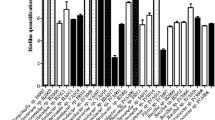Abstract
Recently it was shown that Pyrococcus furiosus uses its flagella not only for swimming, but also for establishment of cell–cell connections, and for adhesion to abiotic surfaces. Therefore, it was asked here if P. furiosus might be able to adhere also to biotic surfaces. Since Methanopyrus kandleri can be found in habitats similar to those of P. furiosus (seawater close to the boiling point and anaerobic conditions) it was tested if interactions between both archaea occur. Using a standard medium and a gas phase reduced in H2 (compared with the optimal gas phase for M. kandleri) we were able to grow both species in a stable coculture. Very interestingly, M. kandleri could adhere to glass under such conditions, but not P. furiosus. This latter archaeum, however, was able to adhere onto M. kandleri cells and onto itself, resulting in structured biofilms on glass. These very often appeared as a bottom layer of M. kandleri cells covered by a multitude of P. furiosus cells. Interactions between P. furiosus and M. kandleri were mediated not only by flagella, but also by direct cell–cell contact.



Similar content being viewed by others
Abbreviations
- TEM:
-
Transmission electron microscopy
- SEM:
-
Scanning electron microscopy
- EPS:
-
Extracellular polymeric substance(s)
References
Boetius A, Ravenschlag K, Schubert CJ, Rickert D, Widdel F, Gieseke A, Amann R, Jorgensen BB, Witte U, Pfannkuche O (2000) A marine microbial consortium apparently mediating anaerobic oxidation of methane. Nature 407:623–626
Fiala G, Stetter KO (1986) Pyrococcus furiosus sp. nov. represents a novel genus of marine heterotrophic archaebacteria growing optimally at 100°C. Arch Microbiol 145:56–61
Granz M (2003) Etablierung und Charakterisierung von Kokulturen hyperthermophiler Bakterien und Archaeen. Diplomarbeit Universität Regensburg
Hall-Stoodley L, Costerton JW, Stoodley P (2004) Bacterial biofilms: from the natural environment to infectious diseases. Nat Rev Microbiol 2:95–107
Johnson MR, Montero CI, Conners SB, Shockley KR, Bridger SL, Kelly RM (2005) Population density-dependent regulation of exopolysaccharide formation in the hyperthermophilic bacterium Thermotoga maritima. Mol Microbiol 55:664–674
Knittel K, Losekann T, Boetius A, Kort R, Amann R (2005) Diversity and distribution of methanotrophic archaea at cold seeps. Appl Environ Microbiol 71:467–479
Kolter R (2005) Surfacing views of biofilm biology. Trends Microbiol 13:1–2
Kurr M, Huber R, König H, Jannasch HW, Fricke H, Trincone A, Kristjansson JK, Stetter KO (1991) Methanopyrus kandleri, gen. and sp. nov. represents a novel group of hyperthermophilic methanogens, growing at 110°C. Arch Microbiol 156:239–247
LaPaglia C, Hartzell PL (1997) Stress-induced production of biofilm in the hyperthermophile Archaeoglobus fulgidus. Appl Environ Microbiol 63:3158–3163
Michaelis W, Seifert R, Nauhaus K, Treude T, Thiel V, Blumenberg M, Knittel K, Gieseke A, Peterknecht K, Pape T, Boetius A, Amann R, Jorgensen BB, Widdel F, Peckmann J, Pimenov NV, Gulin MB (2002) Microbial reefs in the Black Sea fuelled by anaerobic oxidation of methane. Science 297:1013–1015
Moissl C, Rudolph C, Rachel R, Koch M, Huber R (2003) In situ growth of the novel SM1 euryarchaeon from a string-of-pearls-like microbial community in its cold biotope, its physical separation and insights into its structure and physiology. Arch Microbiol 180:211–217
Moissl C, Rachel R, Briegel A, Engelhardt H, Huber R (2005) The unique structure of archaeal hami, highly complex cell appendages with nano-grappling hooks. Mol Microbiol 56:361–370
Näther DJ, Rachel R, Wanner G, Wirth R (2006) Flagella of Pyrococcus furiosus: multifunctional organelles, made for swimming, adhesion to various surfaces, and cell-cell contacts. J Bacteriol 188:6915–6923
Paggi RA, Martone CB, Fuqua C, DeCastro RE (2003) Detection of quorum sensing signals in the haloalkaliphilic archaeon Natronococcus occultus. FEMS Microbiol Lett 221:49–51
Palmer RJ, Stoodley P (2007) Biofilms 2007: Broadened horizons and new emphases. J Bacteriol 189:7948–7960
Rudolph C, Wanner G, Huber R (2001) Natural communities of novel archaea and bacteria growing in cold sulphurous springs with a string-of-pearls-like morphology. Appl Environ Microbiol 67:2336–2344
Acknowledgments
The expert technical help of S. Dobner and E. Papst is gratefully acknowledged. We want to thank Guido Grossmann (Cell Biology, University of Regensburg) for his help with the laser scanning microscopy analysis. This work was supported by grant WI 731/10-1 to RW and RR.
Author information
Authors and Affiliations
Corresponding author
Additional information
Communicated by Jörg Overmann.
Rights and permissions
About this article
Cite this article
Schopf, S., Wanner, G., Rachel, R. et al. An archaeal bi-species biofilm formed by Pyrococcus furiosus and Methanopyrus kandleri . Arch Microbiol 190, 371–377 (2008). https://doi.org/10.1007/s00203-008-0371-9
Received:
Revised:
Accepted:
Published:
Issue Date:
DOI: https://doi.org/10.1007/s00203-008-0371-9




